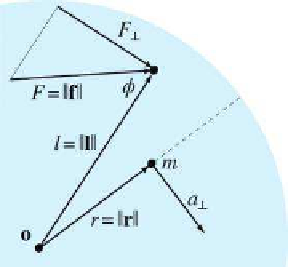Game Development Reference
In-Depth Information
(Don't confuse tangential acceleration, which causes a change in the rate
of rotation, with centripetal acceleration, which is created by contact force
with the disk and maintains the orbital path.)
By definition, the linear tangential acceleration
a
=
p
is simultaneously
an angular acceleration α = θ about the pivot, and they are related by
α = a
⊥
/r.
To understand where this comes from, remember from Section 11.8.1 the
relationship between linear speed and angular velocity: v
⊥
= s = rω.
Now imagine that we keep the mass
fixed at r, but instead of applying our
force directly onto the mass, we push
against a peg that sticks up out of
the disk at some other location, at a
distance l =
l
. The vector
l
goes
from the fulcrum
o
to the point where
the force is applied and is known as
the lever arm. This is shown in Fig-
ure 12.18.
Allow us to clarify a point which is
potentially confusing. Earlier, in
Fig-
the same, since we were applying the
force directly onto the (one and only)
point mass. But in general, mass is dis-
tributed around the disk, so there are
many m's and
r
's. The portion of the applied force that is effective at
rotating the disk is perpendicular to the lever arm, not the radius vector
r
,
as you might infer from Figure 12.17.
Let's consider how changes to the lever arm affect the resulting acceler-
ations. First, we note that if we apply the force anywhere on the circle with
the same radius as the mass, meaning l = r, then the whole apparatus gains
angular momentum, just as if we had pushed against the mass directly. In
other words, the only thing that matters about
l
is the distance from the
fulcrum l =
l
and the angle φ between the lever arm and the applied
force. Rotating both the lever arm and the applied force does not change
the resulting angular acceleration.
If the peg is closer to the fulcrum than the mass (l < r), then we must
push harder in order to produce the same acceleration of the mass. If
l > r, a smaller force will accomplish the job. Thus, increasing the lever
arm l has a proportionate effect on the tangential acceleration a
⊥
of the
mass. This is the basic principle of mechanical advantage of a lever, which
Figure 12.18
Applying a force at an arbitrary point on
the disk with lever arm
l
.










Search WWH ::

Custom Search